A High-Performance Ka-Band Cylindrical Conformal Transceiver Phased Array with Full-Azimuth Scanning Capability
Abstract
1. Introduction
2. Cylindrical Conformal Phased-Array Design
2.1. Antenna Array Design
2.2. Transceiver Channel Design
2.3. Wilkinson Power Divider Network
2.4. Measurement of Gain, NF, and OP1dB for the RF Beam-Control Module
2.5. Calculation of the Array’s G/T and EIRP
3. Measurement Results
3.1. Calibration
3.2. Frequency Response
3.3. Far-Field Radiation Characteristics of the CCTAPA
3.4. Measurement Results of Antenna Array G/T
3.5. Measurement Results of Antenna Array EIRP
4. Discussion
5. Conclusions
Author Contributions
Funding
Institutional Review Board Statement
Informed Consent Statement
Data Availability Statement
Conflicts of Interest
References
- Xiao, Z.; Han, Z.; Nallanathan, A.; Dobre, O.A.; Clerckx, B.; Choi, J.; He, C.; Tong, W. Antenna Array Enabled Space/Air/Ground Communications and Networking for 6G. IEEE J. Sel. Areas Commun. 2022, 40, 2773–2804. [Google Scholar] [CrossRef]
- Jia, Z.; Sheng, M.; Li, J.; Niyato, D.; Han, Z. LEO-satellite-assisted UAV: Joint trajectory and data collection for Internet of remote things in 6G aerial access networks. IEEE Internet Things J. 2021, 8, 9814–9826. [Google Scholar] [CrossRef]
- Fang, X.; Feng, W.; Wang, Y.; Chen, Y.; Ge, N.; Ding, Z.; Zhu, H. NOMA-based hybrid satellite-UAV-terrestrial networks for 6G maritime coverage. IEEE Trans. Wirel. Commun. 2023, 22, 138–152. [Google Scholar] [CrossRef]
- Ghamari, M.; Rangel, P.; Mehrubeoglu, M.; Tewolde, G.S.; Sherratt, R.S. Unmanned aerial vehicle communications for civil applications: A review. IEEE Access. 2022, 10, 102492–102531. [Google Scholar] [CrossRef]
- Han, R.; Bai, L.; Wen, Y.; Liu, J.; Choi, J.; Zhang, W. UAV-aided backscatter communications: Performance analysis and trajectory optimization. IEEE J. Sel. Areas Commun. 2021, 39, 3129–3143. [Google Scholar] [CrossRef]
- Li, K.-X.; Guo, Z.-J.; Hao, Z.-C. A Multipolarized Planar Phased Array for LEO SATCOM Applications. IEEE Antennas Wirel. Propag. Lett. 2022, 21, 2273–2277. [Google Scholar] [CrossRef]
- Wei, C.Y. A dual circularly polarized SIW-fed phased array antenna with wide-angle beam scanning range. IEEE Trans. Antennas Propag. 2022, 70, 7393–7402. [Google Scholar] [CrossRef]
- Kim, D.; Hwang, M.; Kim, G.; Kim, S. Self-Deployable Circularly Polarized Phased Yagi–Uda Antenna Array Using 3-D Printing Technology for CubeSat Applications. IEEE Antennas Wirel. Propag. Lett. 2022, 21, 2249–2253. [Google Scholar] [CrossRef]
- Das, S.; Sharma, S.K.; Waldstein, S.W.; Downey, J.M.; Schoenholz, B.L.; Dever, S.M.; Nessel, J.A.; Banerjee, R. A Flat-Panel 8 × 8 Wideband K-/Ka-Band Dual Circularly Polarized Phased Array Antenna for CubeSat Communications. IEEE Trans. Antennas Propag. 2023, 71, 4153–4166. [Google Scholar] [CrossRef]
- Yan, T.-Y.; Ding, X.-H.; Yang, J.-Y.; Chen, J.-X. A Low-Cost Compact Dual-Polarized Patch Antenna Array for 5G Massive MIMO Base Station. IEEE Antennas Wirel. Propag. Lett. 2024, 23, 1381–1385. [Google Scholar] [CrossRef]
- Chieh, J.-C.S.; Yeo, E.; Farkouh, R.; Castro, A.; Kerber, M.; Olsen, R.B.; Merulla, E.J.; Sharma, S.K. Development of flat panel active phased array antennas using 5G silicon RFICs at Ku- and Ka-bands. IEEE Access 2020, 8, 192669–192681. [Google Scholar] [CrossRef]
- Liu, H.; Qing, A.; Xu, Z.; Yu, Z.; Zhang, S. Design of physically connected wideband SIW cavity-backed patch antenna for wide-angle scanning phased arrays. IEEE Antennas Wirel. Propag. Lett. 2021, 20, 406–410. [Google Scholar] [CrossRef]
- Mailloux, R.J. Phased Array Antenna Handbook, 3rd ed.; Artech House: Norwood, MA, USA, 2017; pp. 235–508. [Google Scholar]
- Low, K.K.W.; Nafe, A.; Zihir, S.; Kanar, T.; Rebeiz, G.M. A scalable circularly-polarized 256-element Ka-band phased-array SATCOM transmitter with ±60° beam scanning and 34.5 dBW EIRP. In Proceedings of the 2019 IEEE MTT-S International Microwave Symposium, Boston, MA, USA, 2–7 June 2019; pp. 1064–1067. [Google Scholar]
- Low, K.K.W.; Zihir, S.; Kanar, T.; Rebeiz, G.M. A Scalable Switchable Dual-Polarized 256-Element Ka-Band SATCOM Transmit Phased-Array with Embedded RF Driver and ±70◦ beam scanning. In Proceedings of the 2020 IEEE/MTT-S International Microwave Symposium, Los Angeles, CA, USA, 4–6 August 2020; pp. 821–824. [Google Scholar]
- Nafe, A.; Sayginer, M.; Kibaroglu, K.; Rebeiz, G.M. 2×64 dual-polarized dual-beam single-aperture 28 GHz phased array with high cross-polarization rejection for 5G polarization MIMO. In Proceedings of the 2019 IEEE MTT-S International Microwave Symposium, Boston, MA, USA, 2–7 June 2019; pp. 484–487. [Google Scholar]
- Nafe, A.; Sayginer, M.; Kibaroglu, K.; Rebeiz, G.M. 2×64-element dual-polarized dual-beam single-aperture 28-GHz phased array with 2×30 Gb/s links for 5G polarization MIMO. IEEE Trans. Microw. Theory Tech. 2020, 68, 3872–3884. [Google Scholar] [CrossRef]
- Lin, H.S.; Cheng, Y.J. A tiling method for sub-arrayed spherical conformal phased array antennas based on maximum 3-D space entropy model. IEEE Trans. Antennas Propag. 2024, 72, 2513–2523. [Google Scholar] [CrossRef]
- Sengupta, D.; Smith, T.; Larson, R. Radiation characteristics of a spherical array of circularly polarized elements. IRE Trans. Antennas Propag. 1968, 16, 2–7. [Google Scholar] [CrossRef]
- Rao, V.S.; Srinivasan, V.V.; Pal, S. Generation of dual beams from spherical phased array antenna. Electron. Lett. 2009, 45, 441–442. [Google Scholar] [CrossRef]
- Braaten, B.D.; Roy, S.; Irfanullah, I.; Nariyal, S.; Anagnostou, D.E. Phase-compensated conformal antennas for changing spherical surfaces. IEEE Trans. Antennas Propag. 2014, 62, 1880–1887. [Google Scholar] [CrossRef]
- Hizal, A. Wide angle scanning conformal phased array on a spherical surface. In Proceedings of the 2013 IEEE International Symposium on Phased Array Systems and Technology, Waltham, MA, USA, 15–18 October 2013; pp. 259–266. [Google Scholar]
- Srinivasan, V.V.; Kumar, C.; Kumar, B.P.; Lakshmeesha, V.K.; Pal, S. Design considerations for dual circularly polarized spherical phased array antenna at X-band for spacecraft data transmission. In Proceedings of the 2011 IEEE Applied Electromagnetics Conference (AEMC), Kolkata, India, 18–22 December 2011; pp. 1–4. [Google Scholar]
- Wu, Y.F.; Cheng, Y.J. Spherical conformal antenna array based on 3D printing framework. In Proceedings of the 2016 IEEE MTT-S International Microwave Workshop Series on Advanced Materials and Processes for RF and THz Applications, Chengdu, China, 20–22 July 2016; pp. 1–2. [Google Scholar]
- Kumar, C.; Kumar, B.P.; Kumar, V.S.; Srinivasan, V.V. Dual circularly polarized spherical phased-array antenna for spacecraft application. IEEE Trans. Antennas Propag. 2013, 61, 598–605. [Google Scholar] [CrossRef]
- Oraizi, H.; Soleimani, H. Optimum pattern synthesis of non-uniform spherical arrays using the Euler rotation. IET Microw. Antennas Propag. 2015, 9, 898–904. [Google Scholar] [CrossRef]
- Josefsson, L.; Persson, P. Conformal Array Antenna Theory and Design; Wiley-IEEE Press: Hoboken, NJ, USA, 2006; pp. 49–70. [Google Scholar]
- Gan, T.H.; Liu, A.; Tan, P.K.; Lu, J. A bendable wideband dual-polarization conformal phased-array antenna. IEEE Antennas Wirel. Propag. Lett. 2023, 22, 1952–1956. [Google Scholar] [CrossRef]
- Hussain, S.; Qu, S.W.; Zhang, P.; Wang, X.H.; Yang, S. A low-profile, wide-scan, cylindrically conformal X-band phased array. IEEE Antennas Wirel. Propag. Lett. 2021, 20, 1503–1507. [Google Scholar] [CrossRef]
- Gao, Y.; Jiang, W.; Hu, W.; Wang, Q.; Zhang, W.; Gong, S. A dual-polarized 2-D monopulse antenna array for conical conformal applications. IEEE Trans. Antennas Propag. 2021, 69, 5479–5488. [Google Scholar] [CrossRef]
- Li, A.; Qu, S.W.; Yang, S. Conformal array antenna for applications in wide-scanning phased array antenna systems. IEEE Antennas Wirel. Propag. Lett. 2022, 21, 1762–1766. [Google Scholar] [CrossRef]
- Jamal, H.A.; Hu, C.; Kwao, E.; Zeng, K.; Tentzeris, M.M. Toward 5G/mm-wave shape-changing origami-inspired phased arrays for near-limitless arbitrarily reconfigurable radiation patterns: Realiza tion, actuation, and calibration. IEEE Trans. Microw. Theory Techn. 2025, 73, 397–411. [Google Scholar] [CrossRef]
- You, D. A Ka-band 64-element deployable active phased-array TX on a flexible hetero segmented liquid crystal polymer for small satellites. IEEE Microw. Wireless Technol. Lett. 2023, 33, 903–906. [Google Scholar] [CrossRef]
- Peng, J.-J.; Qu, S.-W.; Xia, M.; Yang, S. Conformal phased array antenna for unmanned aerial vehicle with ±70 scanning range. IEEE Trans. Antennas Propag. 2021, 69, 4580–4587. [Google Scholar] [CrossRef]
- Pozar, D.M. Microstrip antennas. Proc. IEEE 1992, 80, 79–91. [Google Scholar] [CrossRef]
- Visser, H.J. Array and Phased Array Antenna Basics; Wiley: Hoboken, NJ, USA, 2006; pp. 244–267. [Google Scholar]
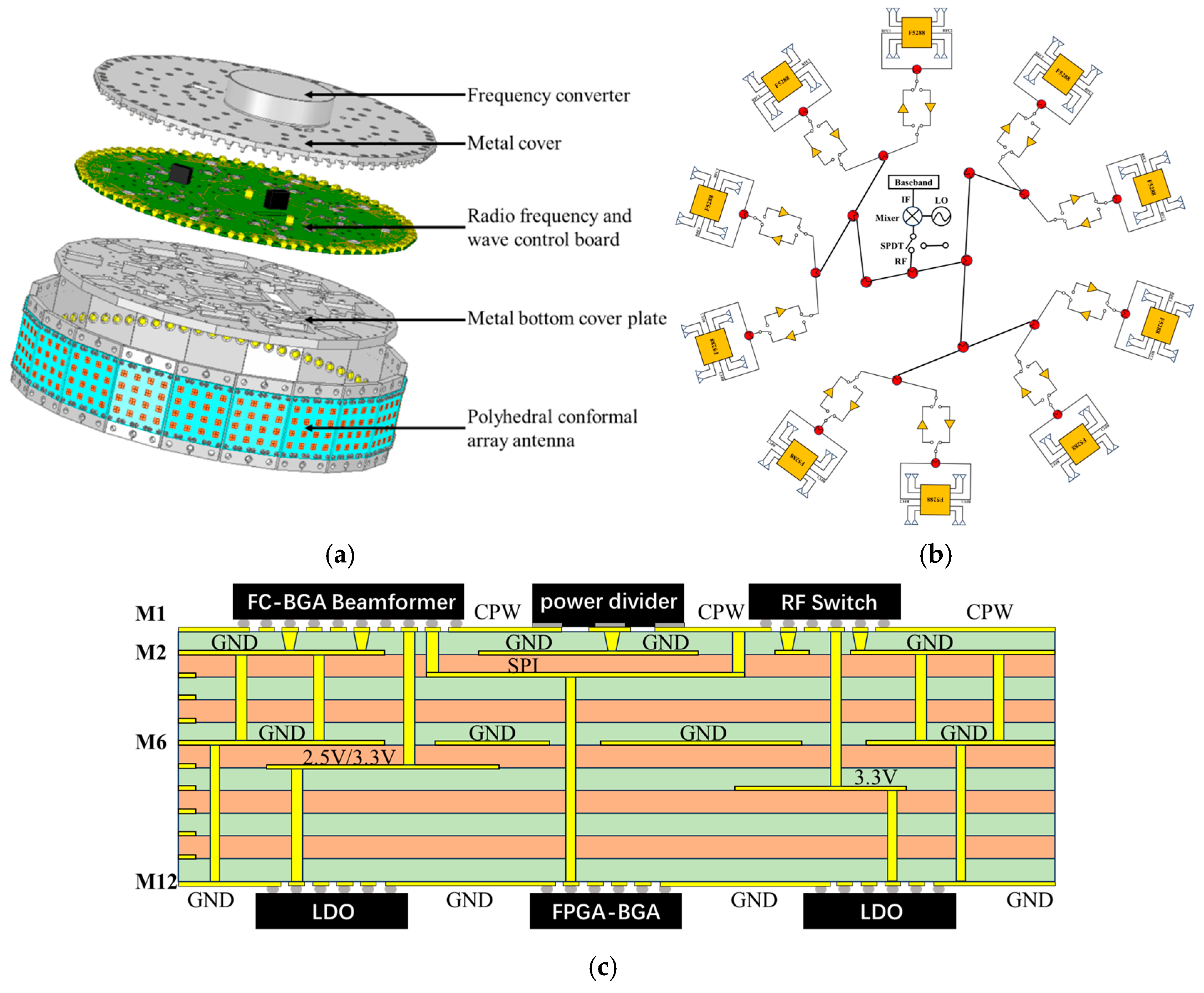

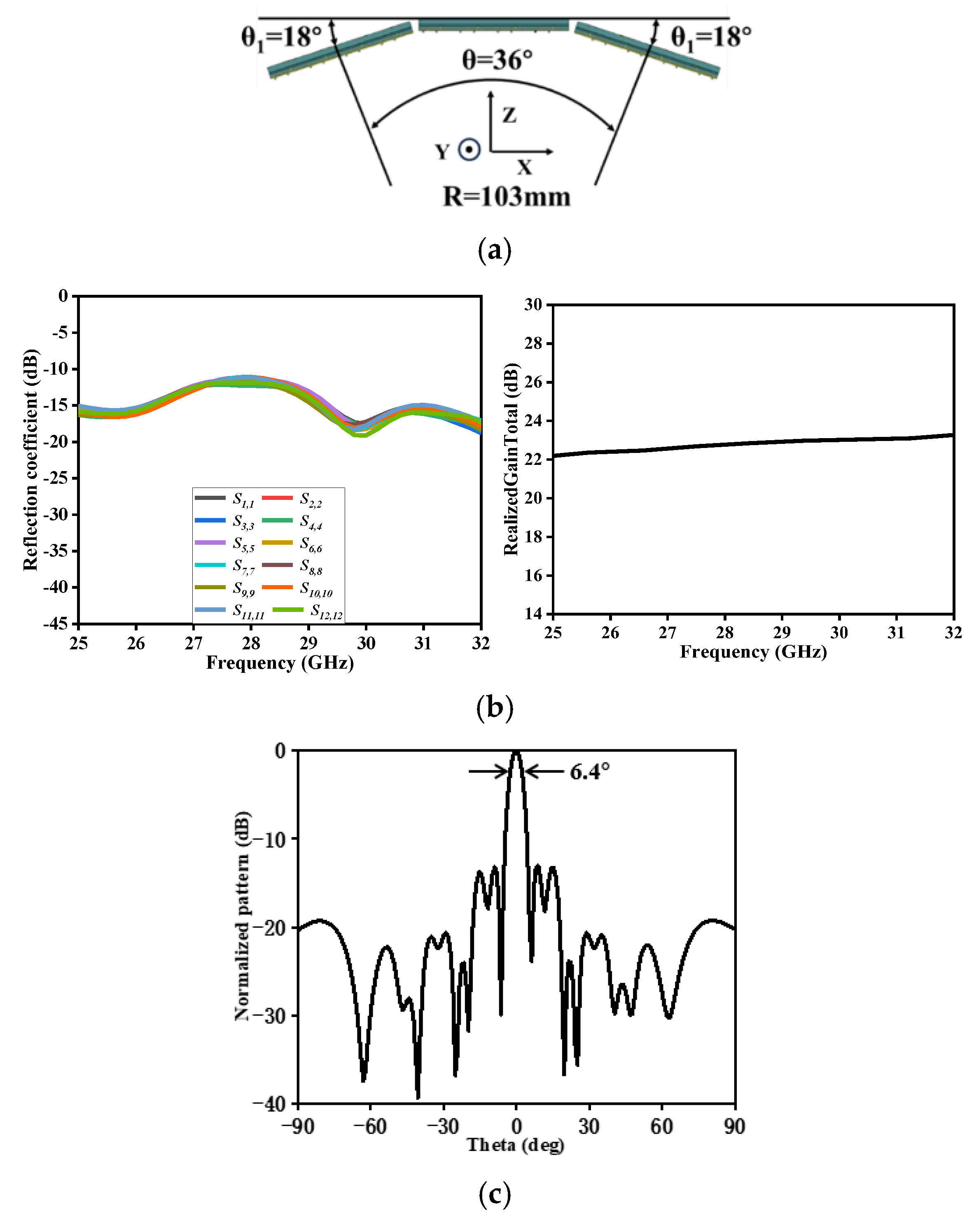
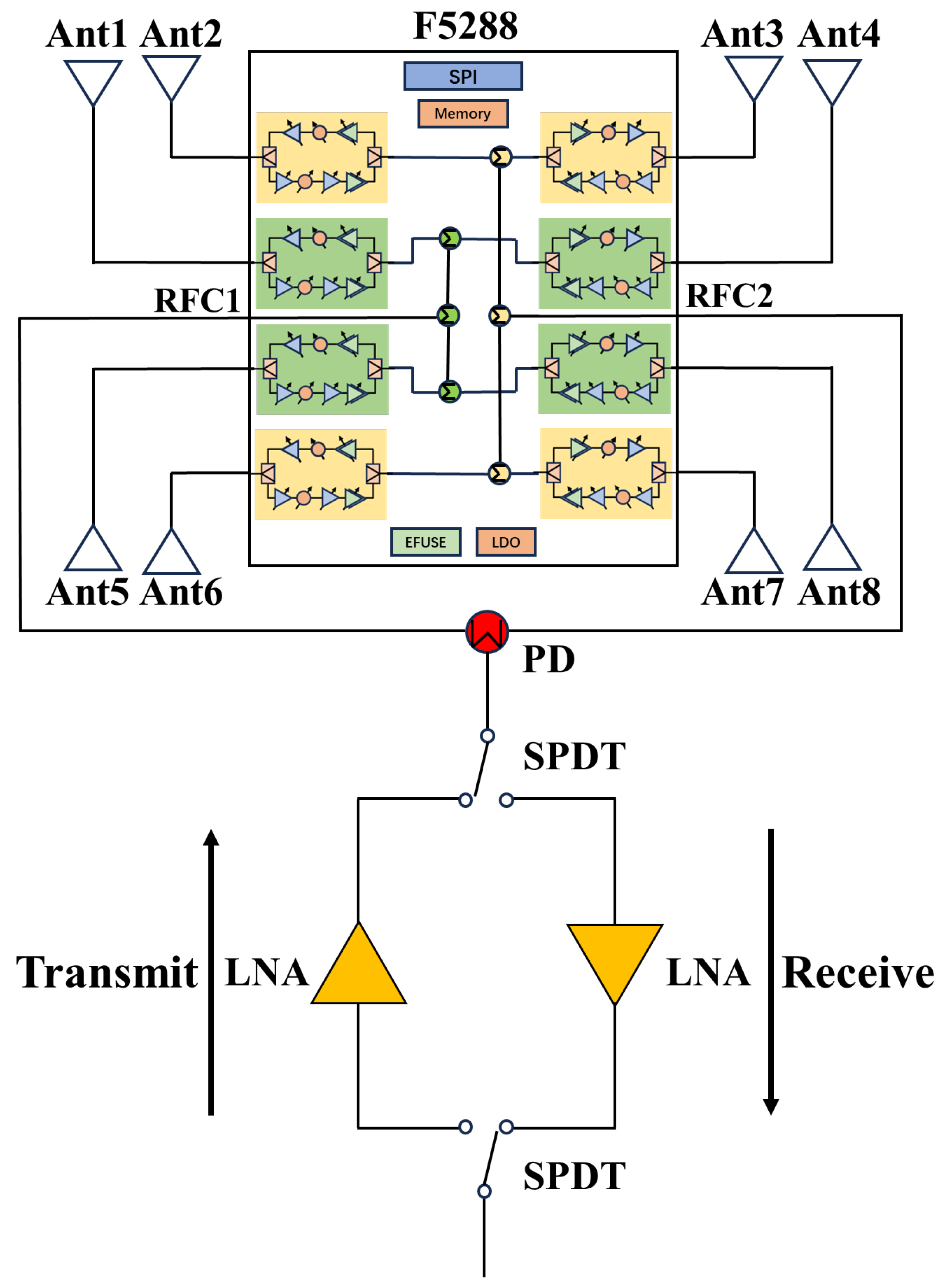

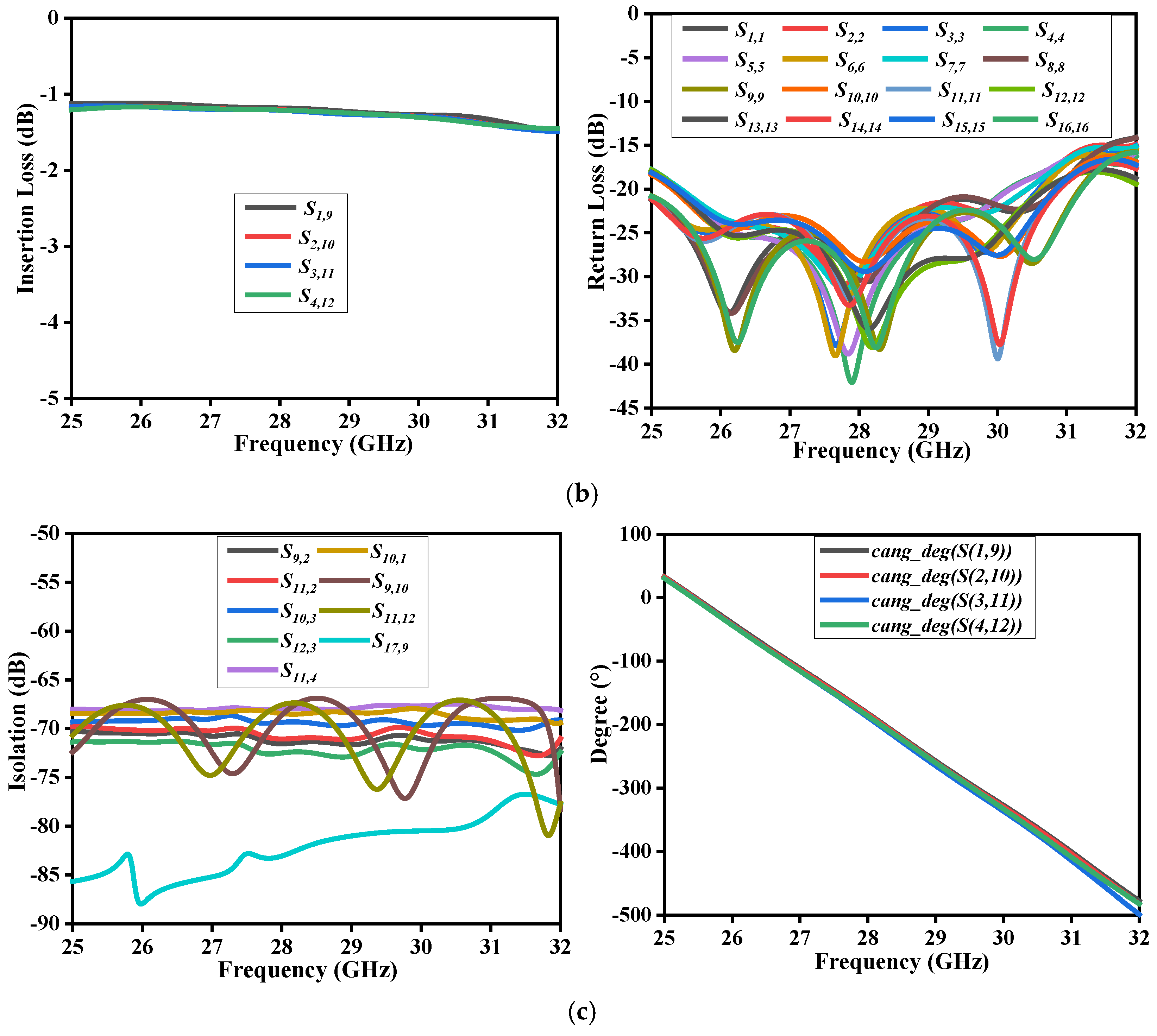
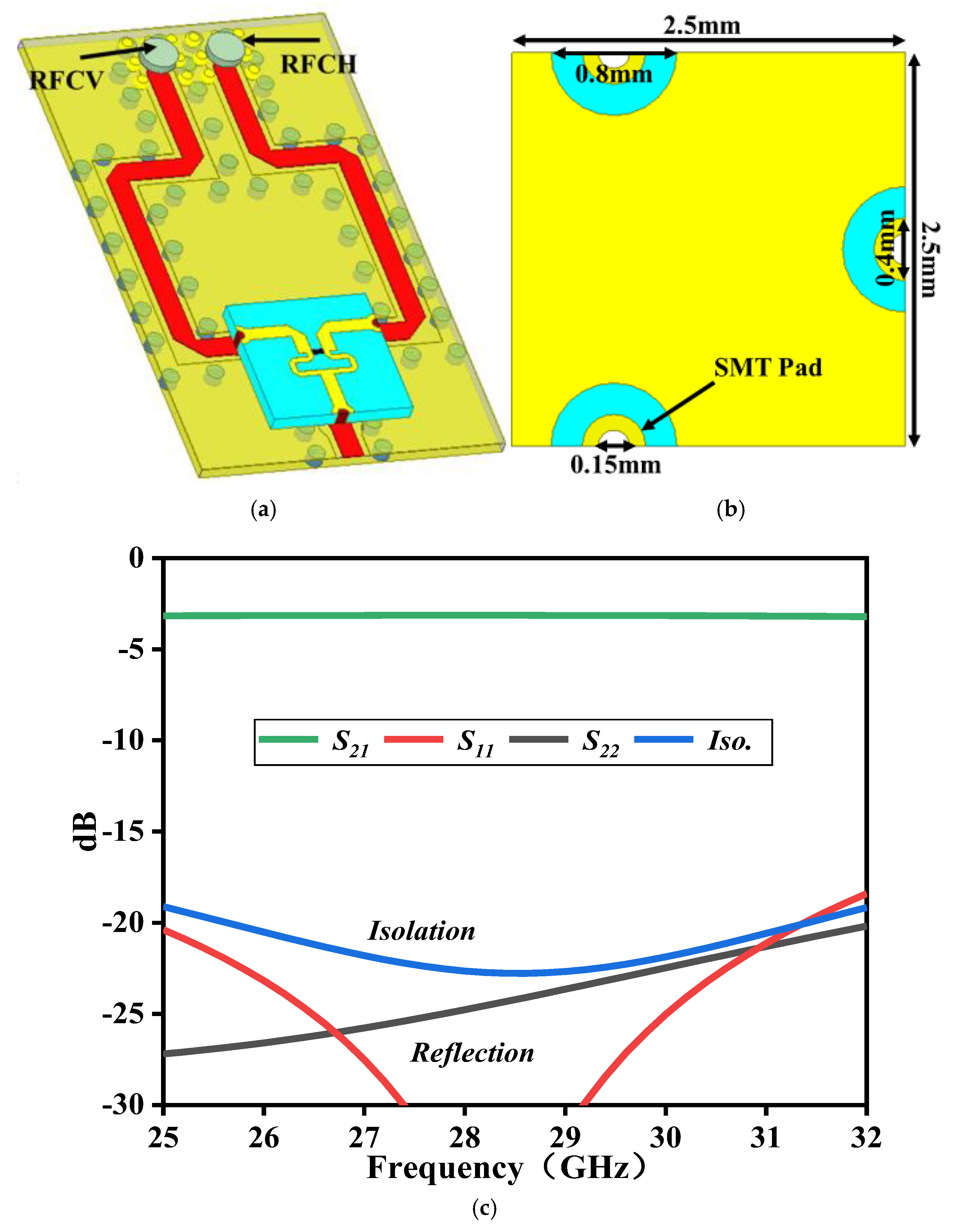


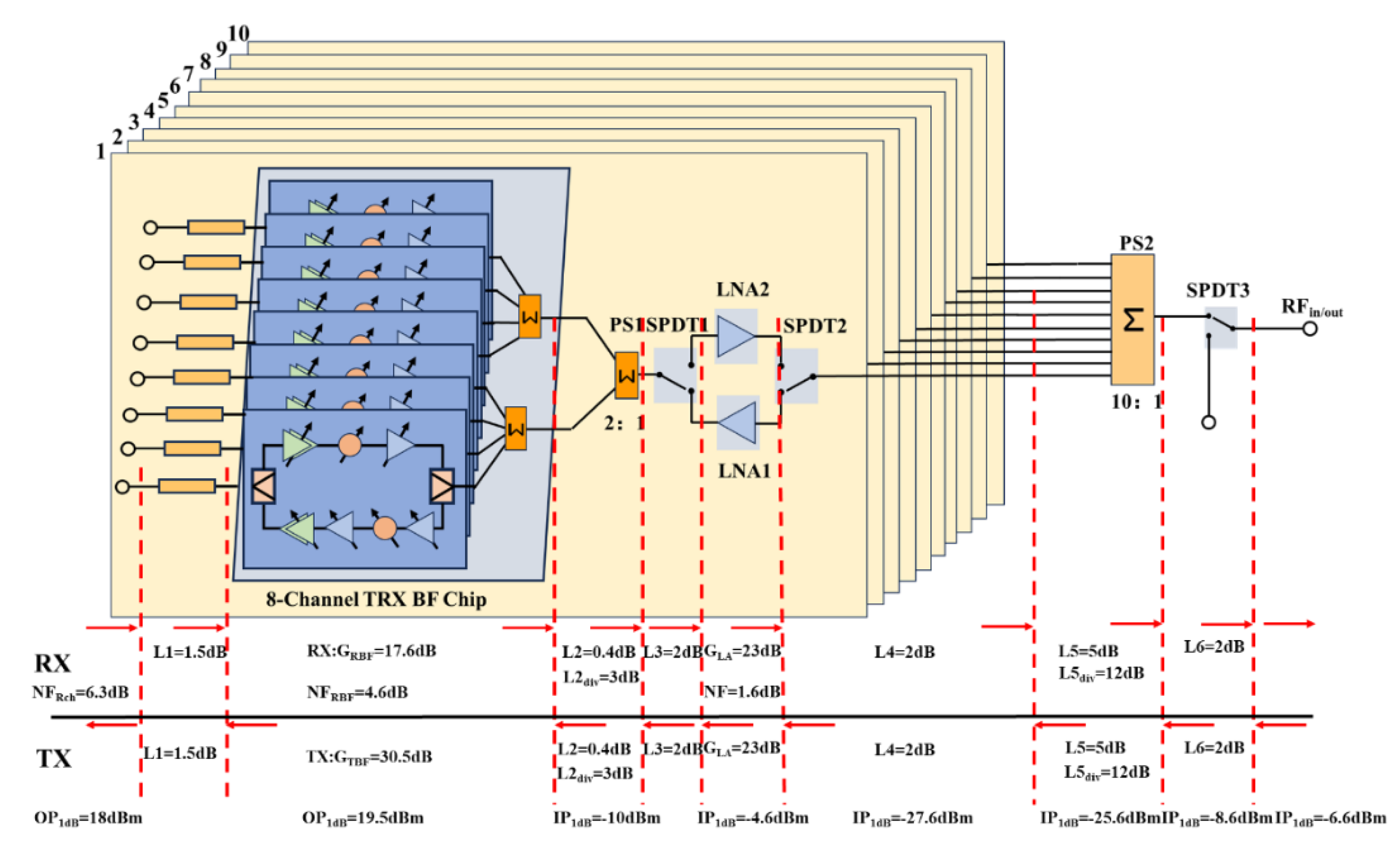

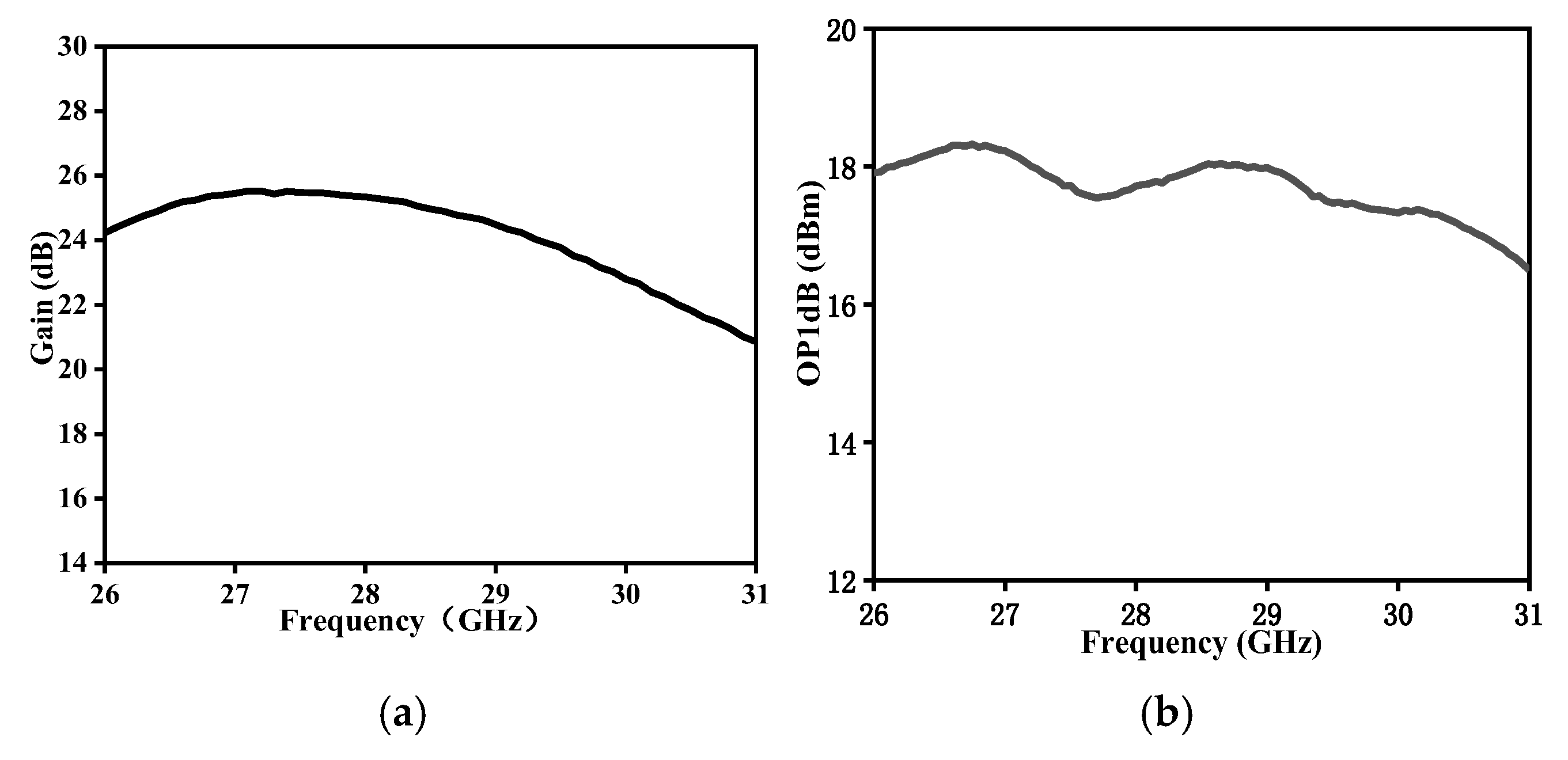
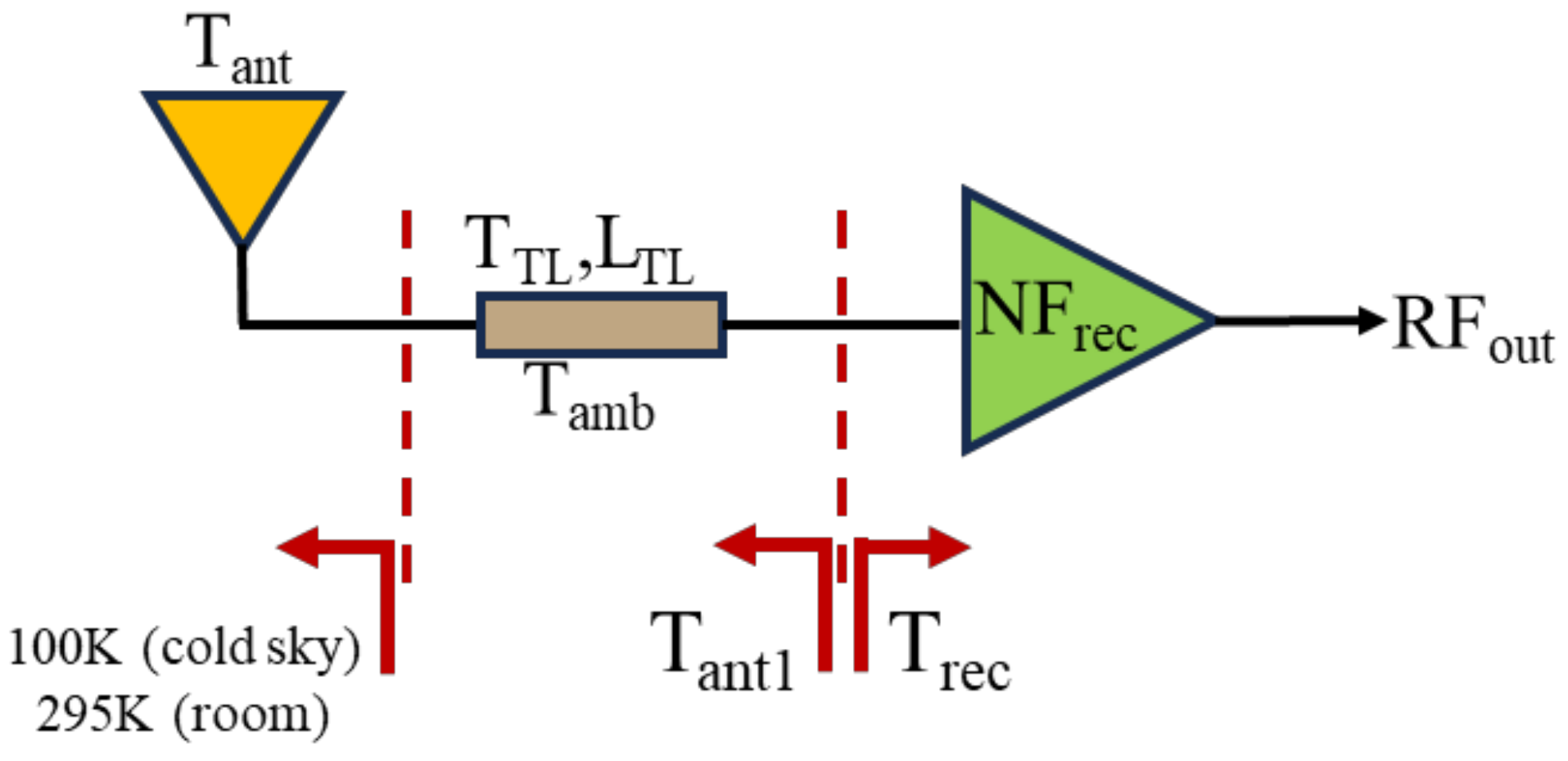
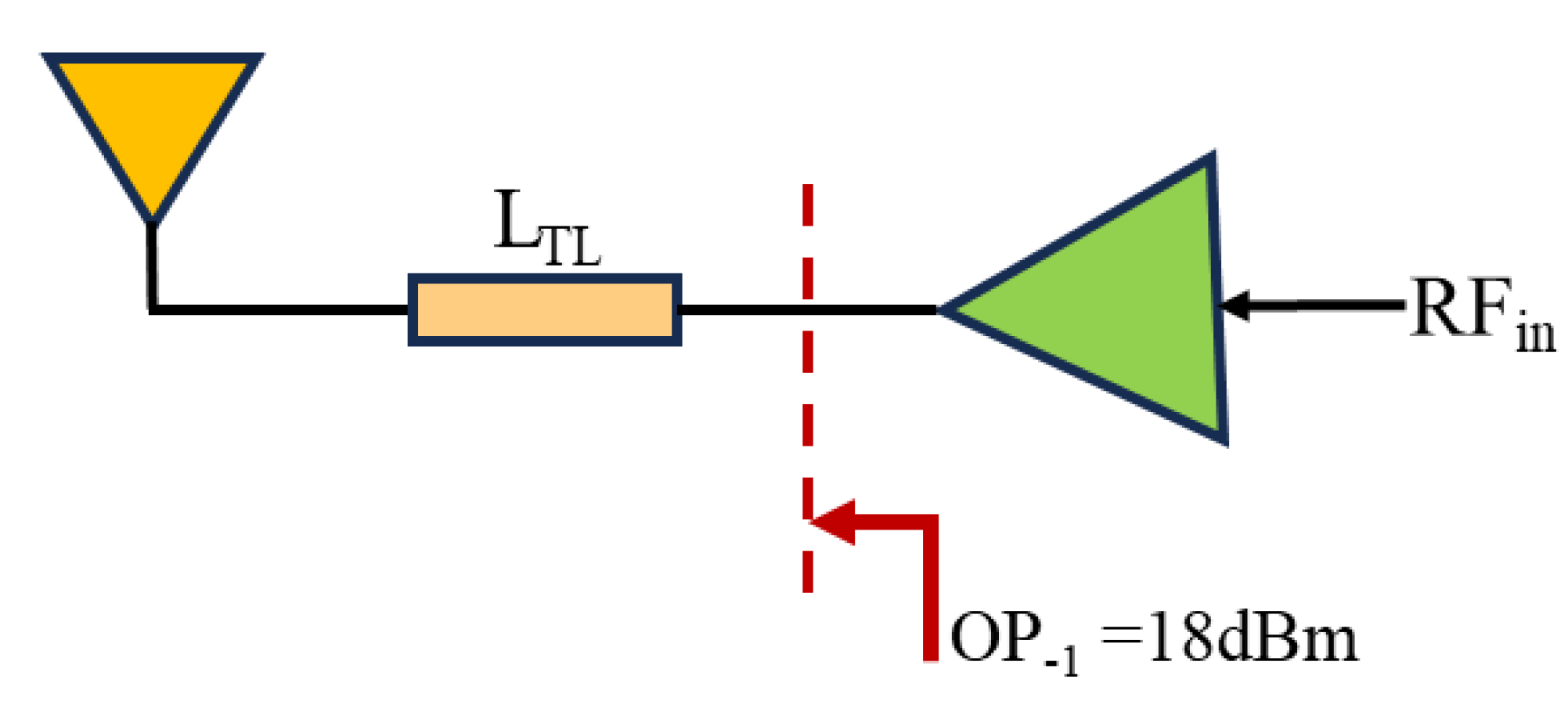
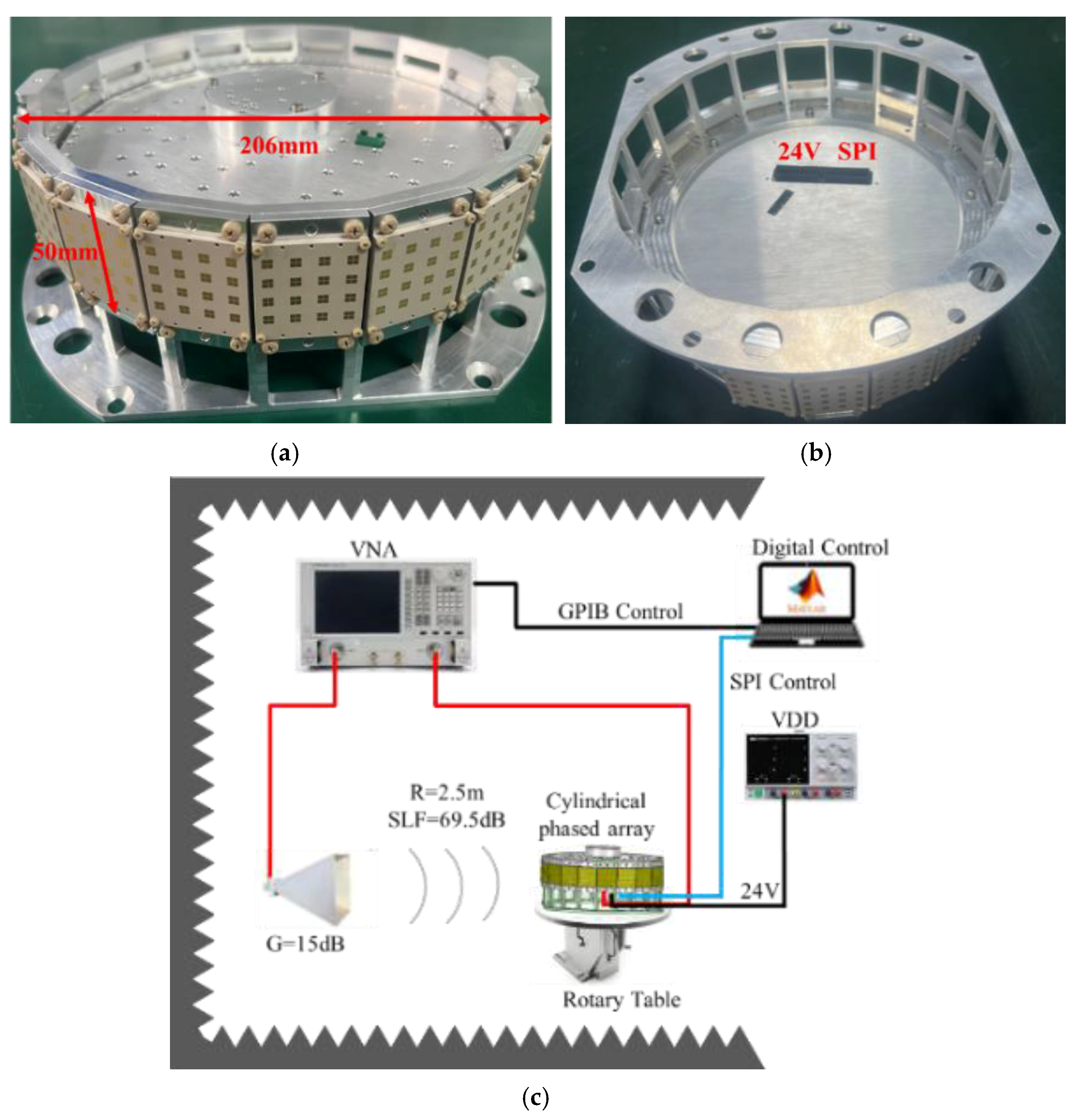
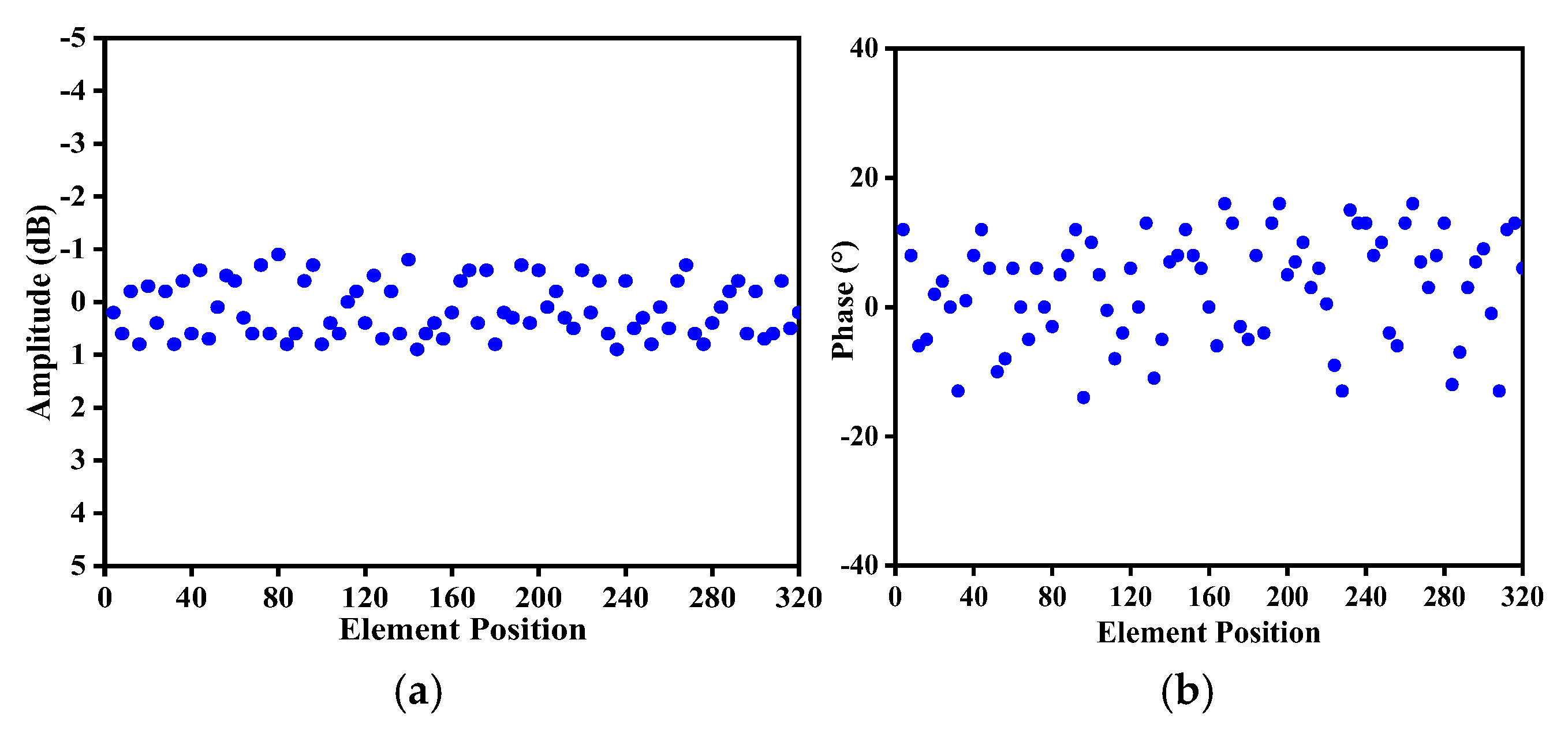
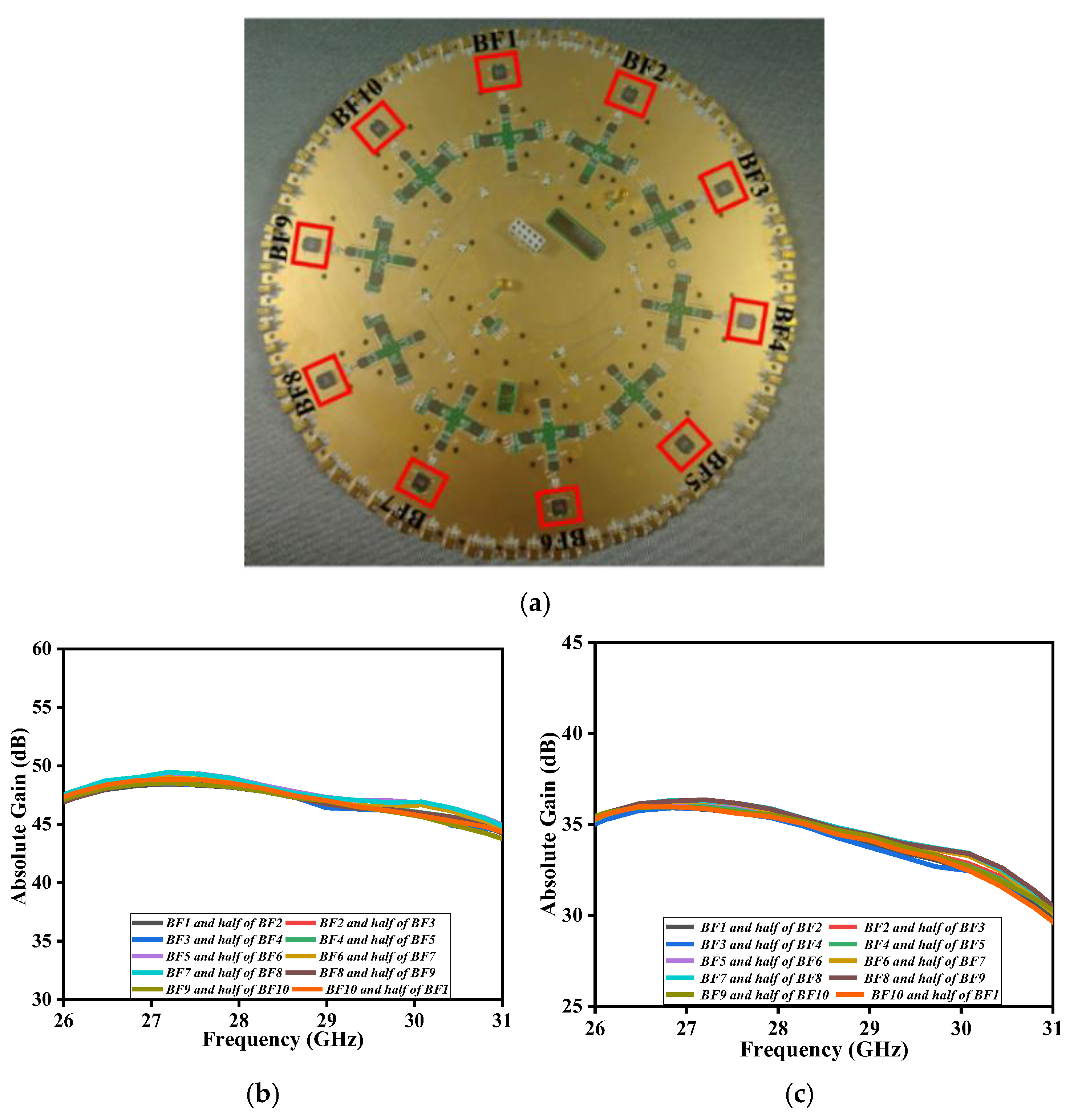



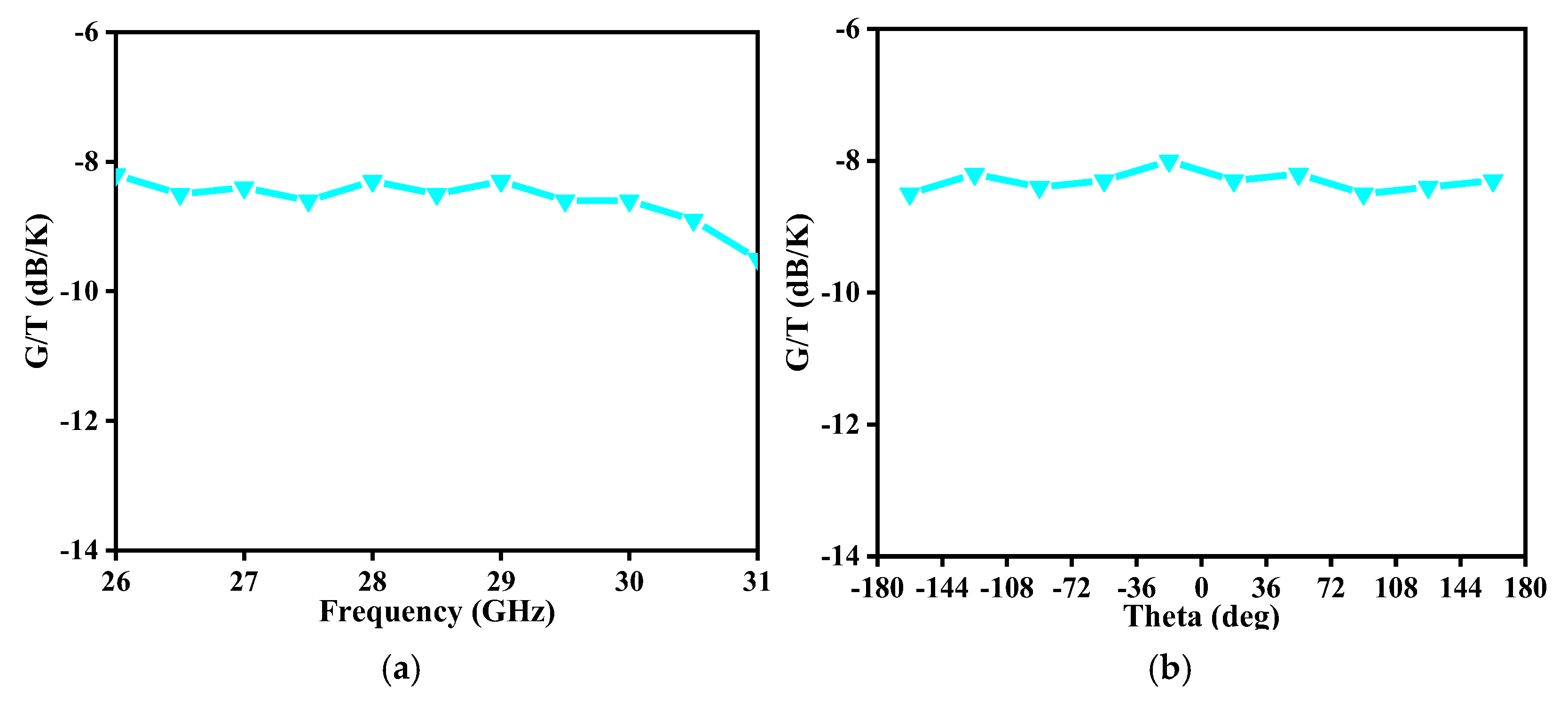

| Parameter | Unit | F5288 | ADRF5020 | QPA2628 |
|---|---|---|---|---|
| Frequency | GHz | 26~31 | 0.01~31 | 22~31.5 |
| No. of Channels | - | 8 | 1 | 1 |
| Work Model | TRX | - | - | |
| Package | - | FCCSP | LGA | QFN |
| Insertion Loss | dB | - | 2@30 GHz | - |
| TX Typical Gain | dB | 30.5 | - | - |
| TX Typical OP1dB | dBm | 19.5 | - | - |
| Phase Shifter (PS) | bit | 6 | - | - |
| PS Phase Step | degree | 5.625 | - | - |
| TX Typical PS Phase Error | degree rms | 0.9 | - | - |
| TX VGA | bit | 6 | - | - |
| VGA Step | dB | 0.5 | - | - |
| TX VGA Gain Control Range | dB | 30.5 | - | - |
| TX VGA Gain Error | dB rms | 0.15 | - | - |
| TX Power/Channel | mW | 675 | - | - |
| TX Supply Voltage | V | 2.5 V | - | - |
| RX Typical Gain | dB | 17.6 | - | 23 |
| Typical Noise Figure | dB | 4.6 | - | 1.6 |
| RX Typical IP1dB | dBm | −28.5 | - | −4 |
| RX Typical PS Phase Error | degree rms | 1.4 | - | - |
| RX VGA | bit | 5 | - | - |
| VGA Step | dB | 0.5 | - | - |
| RX VGA Gain Control Range | dB | 15.5 | - | - |
| RX VGA Gain Error | dB rms | 0.1 | - | - |
| RX Power/Channel | mW | 210 | - | 315 |
| RX Supply Voltage | V | 2.5 | 3.5 | 3.5 |
| Beamforming Chip Identification | Beam Identification |
|---|---|
| BF1 and half of BF2 | Beam 1 |
| BF2 and half of BF3 | Beam 2 |
| BF3 and half of BF4 | Beam 3 |
| BF4 and half of BF5 | Beam 4 |
| BF5 and half of BF6 | Beam 5 |
| BF6 and half of BF7 | Beam 6 |
| BF7 and half of BF8 | Beam 7 |
| BF8 and half of BF9 | Beam 8 |
| BF9 and half of BF10 | Beam 9 |
| BF10 and half of BF1 | Beam 10 |
| Reference | This work | [29] | [28] | [23] | [31] | [34] |
| Frequency (GHz) | 26~31 | 6~12 | 10.7~12.75 | 8.2125 | 2.4~3 | 2.55~3.12 |
| Element type | Patch antenna | Patch antenna | Patch antenna | Waveguide antenna | Patch antenna | Patch antenna |
| Polarization | Linear | Linear | Dual polarization | Dual-circular | Linear | Linear |
| Modes of operation | TRX | - | RX | TX | - | - |
| Array scale | 320 | 48 | 4 × 8 | 64 | 1 × 12 | 1 × 8 |
| Array shape | Cylindrically Conformal | Cylindrically Conformal | Cylindrically Conformal | Spherical Conformal | Wing Conformal | UAV Conformal |
| Active integration | YES | No | Yes | Yes | No | No |
| Array unit numbers/BF chips | 32 | - | 0.5 | 4 | - | - |
| Beam steering | 1D | 2D | 2D | 2D | 1D | 1D |
| Scan range (°) | 360 | ±60 | ±60 | 360 | ±60 | ±70 |
| Scan gain fluctuation (dB) | 0.8 | 3 | 3 | - | 2 | 1.9 |
| Power per element (W) | 0.027 | - | 1.068 | 9 | - | - |
| Total power (W) | 8.73 | - | 34.176 | 36 | - | - |
| Element size | 0.67 λ × 0.67 λ | 0.48 λ × 0.48 λ | 0.47 λ × 0.59 λ | - | 0.5 λ × 0.54 λ | 0.52 λ × 0.21 λ |
Disclaimer/Publisher’s Note: The statements, opinions and data contained in all publications are solely those of the individual author(s) and contributor(s) and not of MDPI and/or the editor(s). MDPI and/or the editor(s) disclaim responsibility for any injury to people or property resulting from any ideas, methods, instructions or products referred to in the content. |
© 2025 by the authors. Licensee MDPI, Basel, Switzerland. This article is an open access article distributed under the terms and conditions of the Creative Commons Attribution (CC BY) license (https://creativecommons.org/licenses/by/4.0/).
Share and Cite
Liu, W.; Zhang, S.; Zhang, A.; Chen, W. A High-Performance Ka-Band Cylindrical Conformal Transceiver Phased Array with Full-Azimuth Scanning Capability. Appl. Sci. 2025, 15, 8982. https://doi.org/10.3390/app15168982
Liu W, Zhang S, Zhang A, Chen W. A High-Performance Ka-Band Cylindrical Conformal Transceiver Phased Array with Full-Azimuth Scanning Capability. Applied Sciences. 2025; 15(16):8982. https://doi.org/10.3390/app15168982
Chicago/Turabian StyleLiu, Weiwei, Shiqiao Zhang, Anxue Zhang, and Wenchao Chen. 2025. "A High-Performance Ka-Band Cylindrical Conformal Transceiver Phased Array with Full-Azimuth Scanning Capability" Applied Sciences 15, no. 16: 8982. https://doi.org/10.3390/app15168982
APA StyleLiu, W., Zhang, S., Zhang, A., & Chen, W. (2025). A High-Performance Ka-Band Cylindrical Conformal Transceiver Phased Array with Full-Azimuth Scanning Capability. Applied Sciences, 15(16), 8982. https://doi.org/10.3390/app15168982





